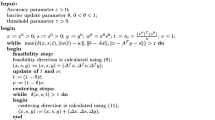Abstract
This paper reviews computational experience with a modeling format and solution algorithm for partial and general economic equilibrium problems. This approach handles cases characterized by weak inequalities, complementary slackness, and ‘nonintegrability’.
The equilibrium is computed by solving a sequence of linear complementarity problems (LCP). Each LCP is obtained by taking a first order Taylor series expansion of the nonlinear equilibrium model, and the LCP is solved by Lemke’s almost complementary pivoting algorithm.
Theoretical results for the convergence of the iterative algorithm are at present available only for the partial equilibrium models. Income effects in the general equilibrium case seem to inhibit similar conclusions. Computational experience with both types of models, however, indicates that the algorithm is both robust and efficient.
Preview
Unable to display preview. Download preview PDF.
Similar content being viewed by others
References
B.H. Ahn and W.W. Hogan, “On convergence of the PIES algorithm for computing equilibria”, Operations Research 30 2 (1982) 281–300.
S.A. Awoniyi and M.J. Todd, “An efficient simplicial algorithm for computing a zero of a convex union of smooth functions”, contributed paper, NBER Conference on Applied General Equilibrium Modeling, San Diego, CA, August 1981.
M.N. Broadie, “An introduction to the octahedral algorithm for the computation of economic equilibria”, Mathematical Programming Study 23 (this volume) (1985).
M. Carey, “Integrability and mathematical programming models: A survey and a parametric approach”, Econometrica 45 (1977) 1957–1976.
R.W. Cottle and G.B. Dantzig, “Complementary pivot theory of mathematical programming”, Linear Algebra and Its Applications 1 (1968) 103–125.
B.C. Eaves, “A locally quadratically convergent algorithm for computing stationary points”, Technical Report SOL 78-13, Systems Optimization Laboratory, Department of Operations Research, Stanford University, (Stanford, CA, 1978).
M.L. Fisher and F.J. Gould, “A simplicial algorithm for the nonlinear complementarity problem”, Mathematical Programming 6 (1974) 281–300.
V. Ginsburgh and J. Waelbroeck, Activity analysis and general equilibrium modelling (North-Holland, Amsterdam, 1981).
T. Hansen and T.C. Koopmans, “On the definition and computation of a capital stock invariant under optimization”, Journal of Economic Theory, 5 3 (1972) 487–523.
N.H. Josephy, “Newton’s method for generalized equations”, MRC Technical Report 1965, University of Wisconsin, Madison, WI, 1979).
T.J. Kehoe, “An example of non-uniqueness of equilibria”, Massachusetts Institute of Technology (Cambridge, MA, 1984).
C.E. Lemke, “Bimatrix equilibrium points and mathematical programming”, Management Science 11 (1965) 681–689.
A.S. Manne and P.V. Preckel, “North-South trade, capital flows and economic growth: An almost neoclassical model”, Department of Operations Research, Stanford University, (Stanford, CA, 1982).
L. Mathiesen, “Efficiency pricing in a linear programming model: A case with constraints on dual variables”, Technical Report SOL 74-18, Stanford University (Stanford, CA, 1974). Revised in The Scandinavian Journal of Economics 4 (1977) 468–477.
L. Mathiesen, “Computational experience in solving equilibrium models by a sequence of linear complementarity problems”, forthcoming in Operations Research (1985).
L. Mathiesen and A. Lont: “Modelling market equilibria: An application to the world steel market”, Working Paper MU04, Center for Applied Research, Norwegian School of Economics and Business Administration (Bergen, 1983).
L. Mathiesen and T. Rutherford, Testing the robustness of an iterative LCP algorithm for solving Walrasian equilibrium models”, Discussion paper 0883, Norwegian School of Economics and Business Administration (Bergen, 1983).
L. Mathiesen and E. Steigum, “Computation of unemployment equilibria in a two-country multi-period model with neutral money”, Discussion paper 1083, Norwegian School of Economics and Business Administration (Bergen, 1983).
O.H. Merrill, “Applications and extensions of an algorithm that computes fixed points of certain upper semi-continuous point to set mappings”, Ph.D. Dissertation, University of Michigan, Ann Arbor, MI, 1972).
B.A. Murtagh and M.A. Saunders, “MINOS 5.0 USER’S GUIDE”, Technical Report SOL 83-20, Department of Operations Research, Stanford University (Stanford, CA, 1983).
J.S. Pang and D. Chan, “Iterative methods for variational and complementarity problems”, Mathematical Programming 24 (1982) 284–313.
P.V. Preckel, “Intertemporal equilibrium models: Developments and results”, Ph.D. Thesis, Department of Operations Research, Stanford University (Stanford, CA, 1983).
T. Rutherford, “Computing general equilibria in a complementarity format. NORGE: A general equilibrium model of the Norwegian economy”, Engineer Degree Thesis, Department of Operations Research, Stanford University (Stanford, CA, 1982).
T. Rutherford, “Solution Time Experiments with VEMOD-S”, Unpublished manuscript, Norwegian School of Economics and Business Administration (Bergen, 1983).
P.A. Samuelson, Foundations of economic analysis (Harvard University Press, Cambridge, MA, 1947).
H.E. Scarf, “Some examples of global instability of the competitive equilibrium”, International Economic Review 1 3 (1960) 157–171.
H.E. Scarf, “The computation of equilibrium prices”, in: K. Arrow and M.D. Intriligator, eds., Handbook of mathematical economics (North-Holland, Amsterdam, 1981).
H.E. Scarf with T. Hansen, Computation of economic equilibria (Yale University Press, New Haven, CT, 1973).
T. Takayama and G.G. Judge, Spatial and temporal price and allocation models (North-Holland, Amsterdam, 1971).
D. Talman and L. Van der Heyden, “Algorithms for the linear complementarity problem which allow an arbitrary starting point”, Tilburg University, Tilburg (The Netherlands, 1982).
M.J. Todd, “A note on computing equilibria in economies with activity analysis models of production”, Journal of Mathematical Economics 6 (1979) 135–144.
J.A. Tomlin, “Robust implementation of Lemke’s method for the linear complementarity problem”, Mathematical Programming Study 7 (1978) 55–60.
H. Varian, Microeconomic analysis (W.W. Norton, New York, 1978).
Author information
Authors and Affiliations
Editor information
Rights and permissions
Copyright information
© 1985 The Mathematical Programming Society, Inc.
About this chapter
Cite this chapter
Mathiesen, L. (1985). Computation of economic equilibria by a sequence of linear complementarity problems. In: Manne, A.S. (eds) Economic Equilibrium: Model Formulation and Solution. Mathematical Programming Studies, vol 23. Springer, Berlin, Heidelberg. https://doi.org/10.1007/BFb0121030
Download citation
DOI: https://doi.org/10.1007/BFb0121030
Received:
Revised:
Published:
Publisher Name: Springer, Berlin, Heidelberg
Print ISBN: 978-3-642-00916-7
Online ISBN: 978-3-642-00917-4
eBook Packages: Springer Book Archive




